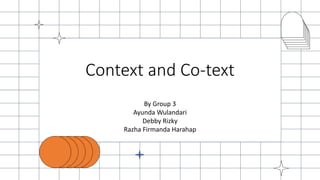
co text and context
- 1. Context and Co-text By Group 3 Ayunda Wulandari Debby Rizky Razha Firmanda Harahap
- 2. Introduction to context ● Context means the parts of meaning that can be explained by knowledge of the physical and social world, and sociopsychological factors influencing communication, as well as the knowledge of the time and place in which the words are utterred or written. (Cutting, 2002) ● Huang (2007) defines context as referring to any rele- vant features of the dynamic setting or environment in which linguistic unit is systematically used.
- 3. Types of Context Yule (2003) • Yule (2003: 129-130) differentiate between two main types of contexts— linguistic context (co-text) and physical context. • Physical context means the time and place where the linguistic expression are encountered. For example, the work ‘bank’ which is identified as homonym; when the word bank is used in a sentence accompanied by the word river, there will be easy to the recognised the meaning of the word ‘bank’. • The same thing will happen, if the word bank used in the phrase like get to the bank to cash a check, it will also be easy to know the meaning of the word bank. • In this case, the meaning of the the word bank are easily to identified because of the linguistic contexts in which the both words of bank are used. • In addition, when the word BANK is hanged out in a building, the place or the location where it is put can help us to catch the meaning of the work bank. • This is because of the help of physical context where the word bank is tied.
- 4. • Huang (2007) believed that context can be divided into three types— physical, linguistic, and general knowledge contexts. • Physical context means the physical setting or spatiotemporal location of the utterance. • Linguistic context refers to the surrounding utterances in the same discourse and it is about what has been mentioned in the previous discourse. • General knowledge context deals with a set of background assumptions (real-world knowledge) shared by the speaker and the address. This is also known as common ground—communal and personal. Communal common ground is the set of background assumption shared by members of a community; whereas personal common ground means the body of back- ground knowledge two members of community share from their past experience each other.
- 5. • Cutting (2002) claims that there are two major types of contexts— contexts outside of text (contexts) and context inside of text (co-texts). • The former type of context is known as extra-linguistic context; the latter one is regarded as linguistic context. • There two type of extralinguistic contexts—situational context and background knowledge context. Further, background knowledge context can be classified into interpersonal context
- 6. Introduction to co-text ● Contextual context is also known as the context of the text itself which is also regarded as co-text ● Co-text includes grammatical cohesion and lexical cohesion. (Cutting, 2002)
- 7. 1) Grammatical Cohesion • Grammatical cohesion refers to the linkage or connection between a referring expression with another referring expression within the co- text (Cutting, 2002). • In short, grammatical cohesion is what interconnects text together. Grammatical cohesion can be grouped into reference, substitution and ellipsis. Types of Grammatical Cohesion Brief explanation (next slide)
- 8. • Reference refers to the act of using language to refer to entities in the context. In other words, it can be stated that reference is the act in which a speaker employs linguistic forms to facilitate the hearer to identify something. • Substitution refers to endophoric references that holds the text together and avoid repetition. • Ellipsis, just like substitution, avoids repetition and depends on the hearer or reader’s being able to retrieve the missing words from the surrounding cotext.
- 9. 1) Lexical Cohesion • Lexical cohesion refers to linguistic devices function to interconnect words in the texts to make a cohesive exchange. • There are four types of lexical cohesion, namely repetition, synonym, superordinate and general words. Types of Grammatical Cohesion Brief explanation (next slides)
- 10. • Repetition One of lexical cohesion devices is by simply repeating words or phrases thoroughly in the texts. It is known as repetition. Mostly writer used repetition in stylistic purpose—to make tasteful effect. • Synonyms Synonym refers to linguistic devices in which to indicate cohesive texts utilised by the speaker or writer by the another word that has the same meaning or almost the same meaning. It is done by the speaker or writer to create enjoyable conversation or interesting essay.
- 11. • Superordinates Superordinate is one way of speaker or writer to avoid word repetition, but using the general term. For example, the speaker or writer can use flower as superordinate of rose, tullip, orchid, etc. Flower is the upper level; whereas rose, tullip, and orchid are lower one. The lower levels are referring to noun classified as superordinate functions as umbrella term. • General Words General words means one kind of lexical cohesion in which speaker or writer use one word a higher level that functions as umbrella term. For example: thing, woman, person, man, etc.
- 12. Conclusion ● In the context of pragmatics, there are two things to be considered; context and co-text. ● Context is how to someone understanding of much of what he reads and hears is tied to the physical context, particularly the time and place, in which someone encounter linguistic expressions. And co-text is based on physical context.